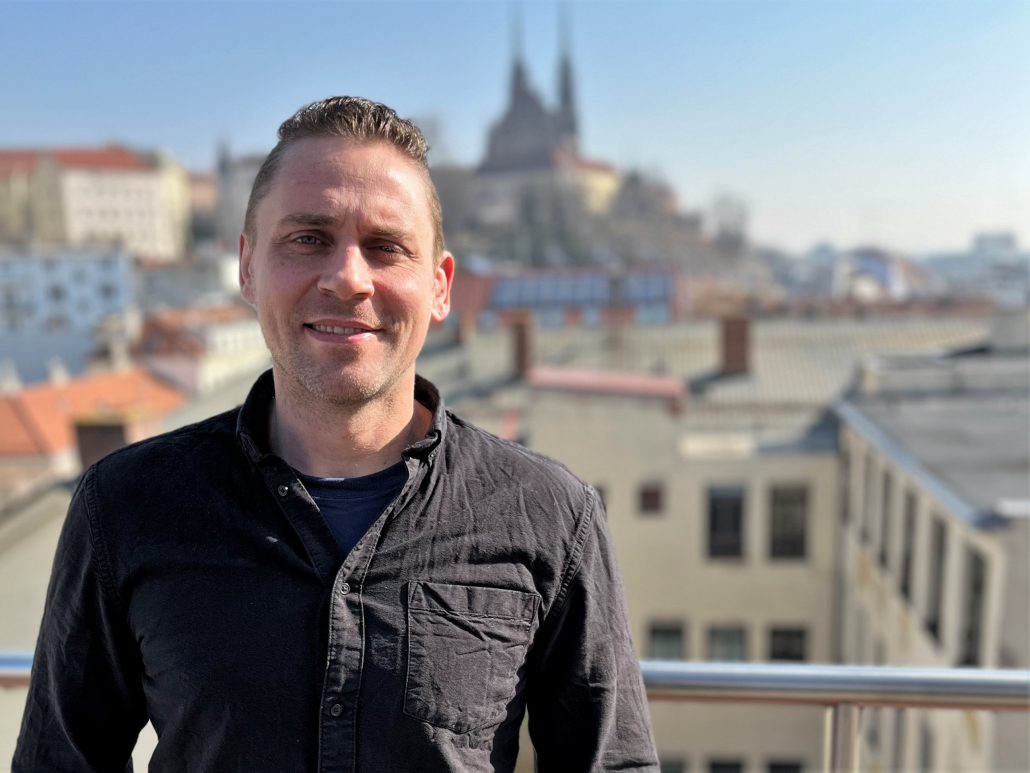Matchbox-sized device set to revolutionise sleep apnea treatment

Obstructive sleep apnea is the second most common sleep disorder in the world. A wearable electronics device is set to revolutionise its treatment. Canadian scientist Adam Williamson is working on its development at the International Clinical Research Centre of the Faculty of Medicine Masaryk University and St. Anne’s University Hospital in Brno.
According to recent studies, Obstructive Sleep Apnea (OSA) affects up to one billion people aged between 30 and 69 years worldwide. Roughly half of them suffer from a moderate to severe form of the disease, classified as five or more breathing cut-offs per hour. The groundbreaking FitSleep project, spearheaded by Dr. Adam Williamson and supported by Somnial Technologies, a dynamic biotech start-up, marks a significant advancement in the treatment of OSA. The FitSleep technology offers a revolutionary alternative to traditional OSA treatments. Unlike the cumbersome and often uncomfortable CPAP machines, FitSleep’s technology stimulates the tongue to maintain an open airway during sleep, all without the need for surgery or invasive procedures.
As the project garners international attention, Dr. Williamson’s leadership and commitment to excellence stand out. “Our vision with FitSleep was to create a solution that is not only effective but also enhances patient comfort and compliance,” says Dr. Williamson. “Seeing this vision come to life has been a remarkable journey. We are excited about the positive impact FitSleep will have on those struggling with sleep apnea.” With clinical trials underway, the FitSleep project is on the cusp of changing the standard of care in sleep medicine, offering a beacon of hope for OSA patients worldwide.
At forty-three years old, Dr. Williamson is the recipient of four previous prestigious European Research Council (ERC) grants; the FitSleep project which he has just received, is now his
fifth ERC, and is also the first ERC Proof of Concept grant for the Faculty of Medicine Masaryk University.
The technology of the project utilizes so-called temporal interference (TI) stimulation, a method of electrical stimulation which Adam Williamson has explored extensively in the
process of deep brain stimulation for the treatment of epilepsy. For TI stimulation, all that is needed are electrodes placed on the skin, which, thanks to adequately selected high frequencies, create an envelope of stimulation that allows precise stimulation of deep targets. “Activating the tongue, located under layers of skin and muscle, can be a difficult target using standard non-invasive stimulation,” explains Williamson, applying knowledge from his original profession as an electrical engineer to his research. “However, by using bilateral TI, we can limit the effect on adjacent tissues and just affect the activation of the tongue directly with the electrical stimulation.”
ERC Proof of Concept grants provide significant financial support to existing ERC grantees to develop their findings and to assess the commercial potential of their projects in progress. “Despite different treatment options, up to eighty percent of apnea patients do not resolve their problem because none of the current solutions will be suitable for them. I am convinced that if they have a device that is easy and comfortable to use, many will change their attitude,” believes Williamson, who settled in Brno after studying and working in Germany, France and Sweden.
Professor Irena Rektorová, the head of the International Clinical Research Centre, is behind his arrival in South Moravia. “Dr. Williamson seeks collaboration with doctors and access to patients for his research, all of which is provided by the St. Anne’s University Hospital in Brno. He has a laboratory with a Faraday cage, i.e. an ideal equipment for his research. In addition,
neuroscience research using various non-invasive stimulation methods is already well established in Brno,” says Professor Rektorová, who herself leads the neuroscience research group at CEITEC MU. “This project is the third ERC grant that Adam Williamson is implementing at the International Clinical Research Centre. While the first two projects he transferred from Marseille, this is the first one he has already received here. This is a very prestigious grant that will significantly strengthen and advance neuromodulation research and collaboration between Brno institutions.”
Mgr. Václav Tesař, Communications manager, Faculty of Medicine Masaryk University, +420
733 553 215, vaclav.tesar@med.muni.cz
Mgr. Martina Jelínková, PR Specialist, St. Anne’s University Hospital, +420 721 655 348,
martina.jelinkova@fnusa.cz


